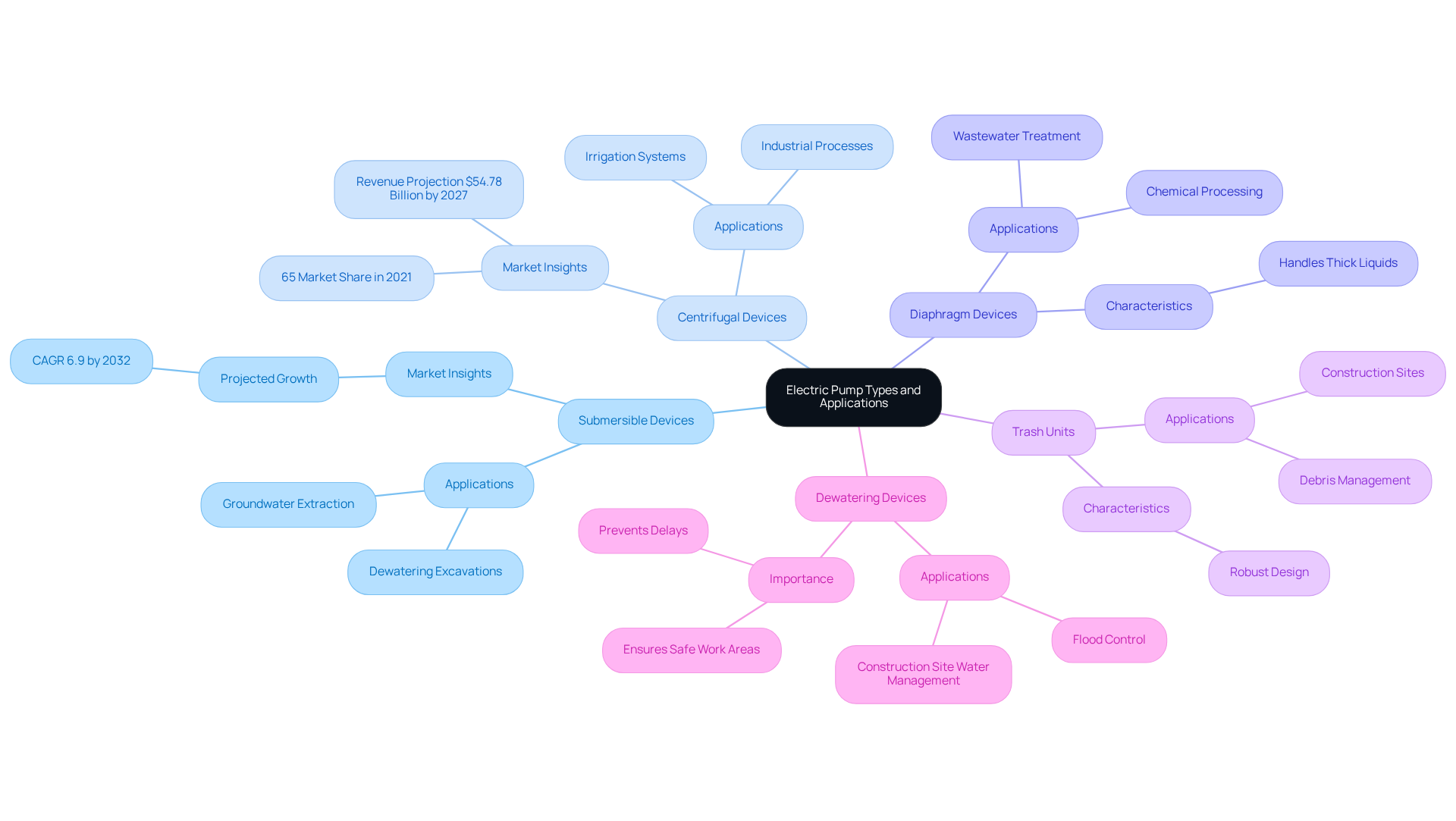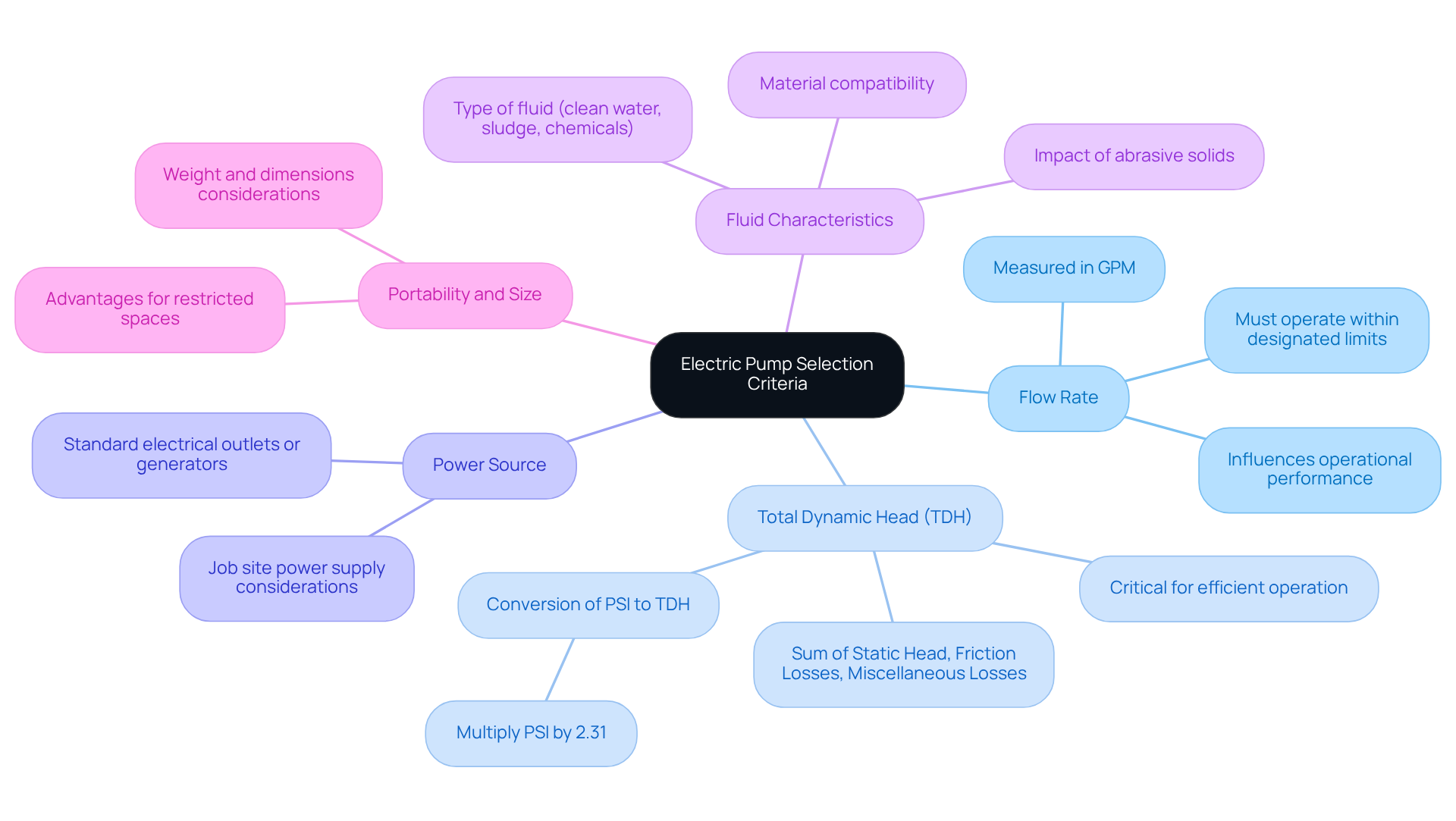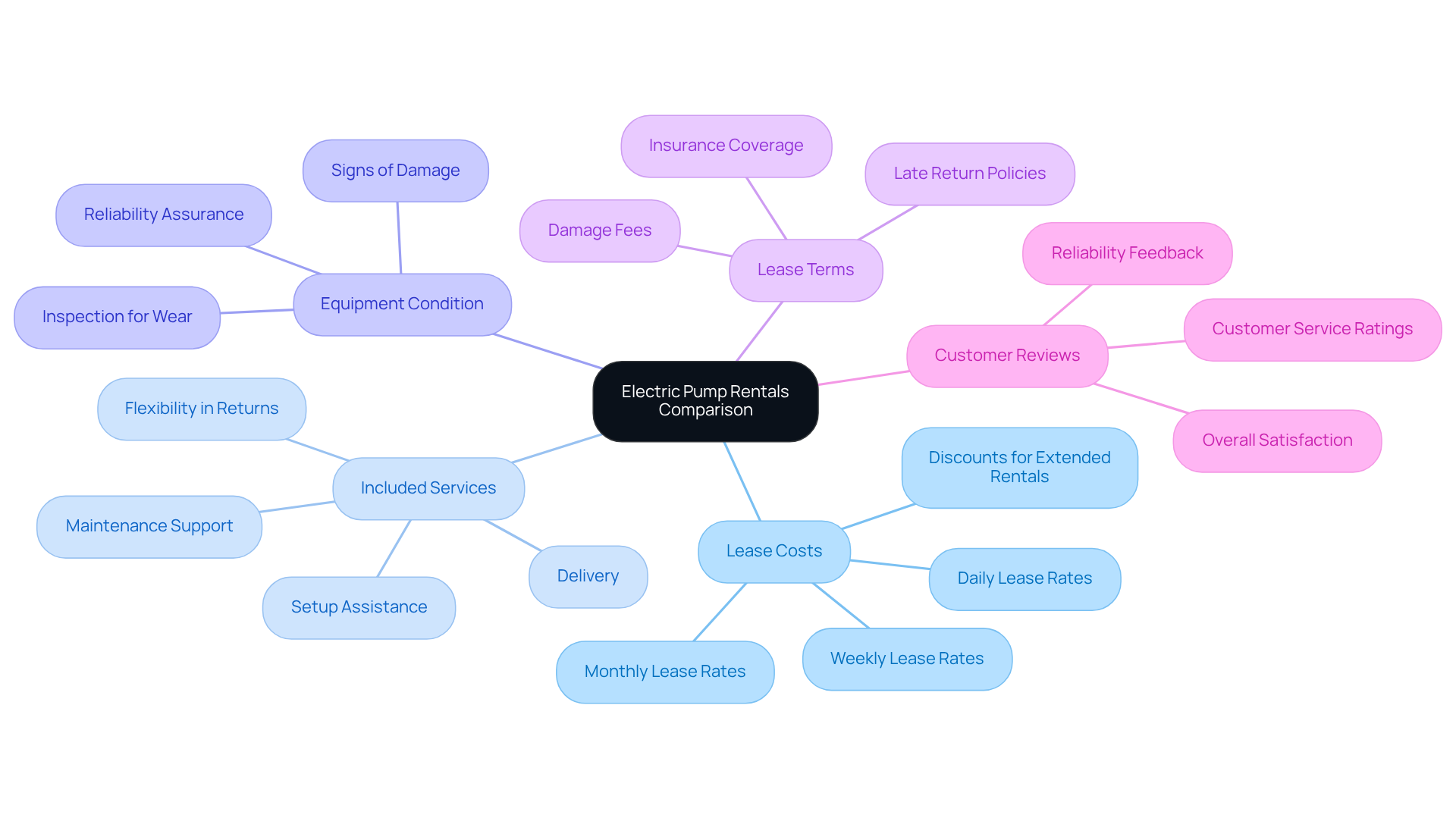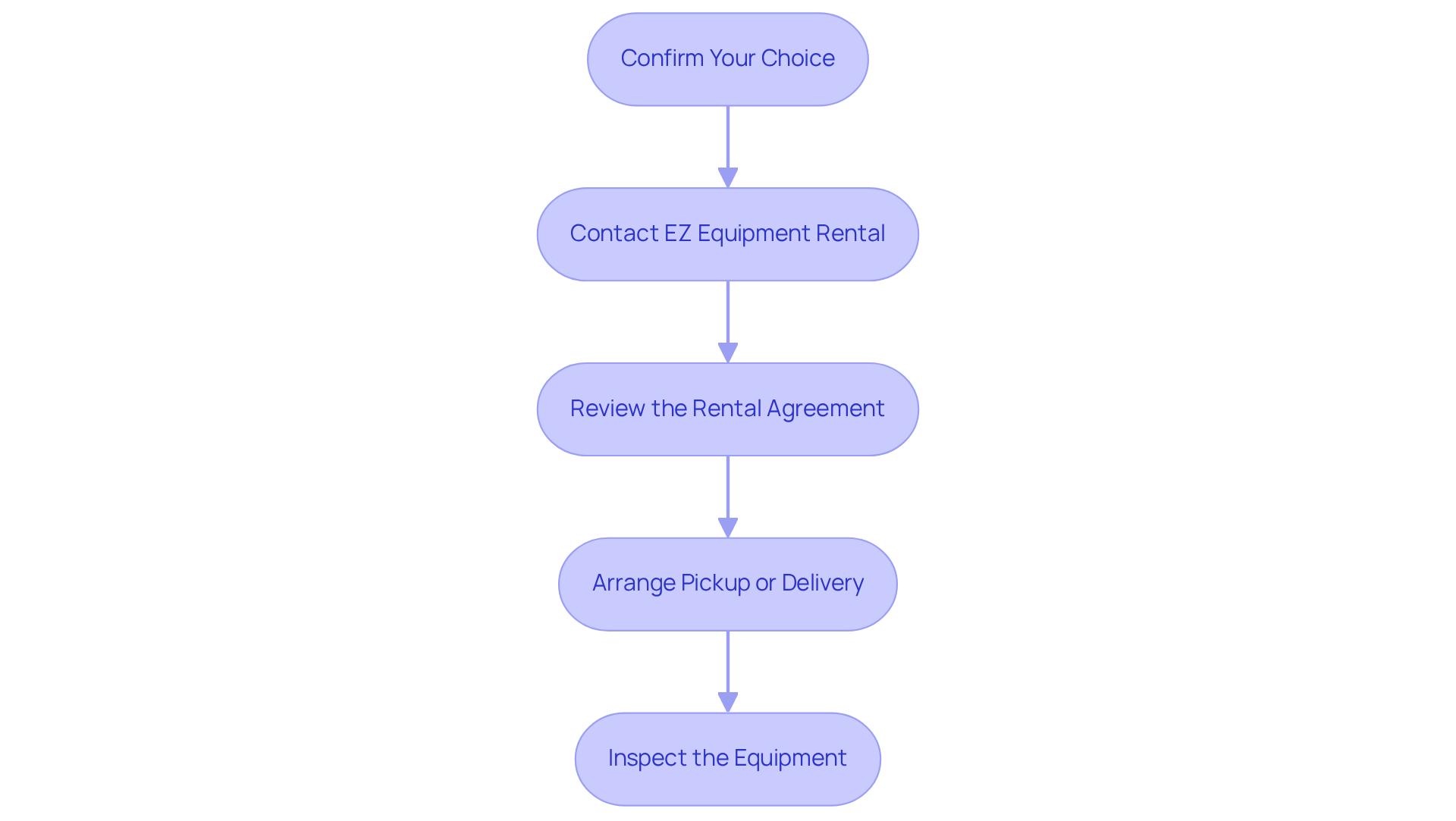Overview
This article delineates four essential steps for efficiently renting electric pumps:
- Select the appropriate device tailored to your project needs.
- Compare rental options to ensure you find the best fit.
- Evaluate costs and services to make informed decisions.
- Finalize the rental process with confidence.
These steps are supported by detailed criteria for pump selection, including flow rate and power source. Furthermore, consider rental terms and equipment reliability, which collectively enhance project efficiency in construction and irrigation applications.
Key Highlights:
- Electric pump rentals are vital in construction and irrigation, enhancing project efficiency.
- Submersible devices are effective for dewatering applications on construction sites.
- Centrifugal devices are ideal for high-flow applications, holding a 65% market share in 2021.
- Diaphragm devices handle thick liquids and slurries, suitable for chemical processing.
- Trash units manage debris-filled water, essential for construction sites.
- Key selection criteria include flow rate, total dynamic head (TDH), power source, fluid characteristics, and portability.
- When comparing rental options, consider lease costs, included services, equipment condition, lease terms, and customer reviews.
- Finalising a rental involves confirming the choice, reviewing the agreement, arranging logistics, and inspecting the equipment.
Introduction
Understanding the nuances of electric pump rentals is crucial for optimizing efficiency across diverse applications, from construction to irrigation. By delving into the various types of electric pumps and their specific uses, readers can unlock the potential for improved project outcomes and significant cost savings.
With a multitude of options available and essential selection criteria to consider, navigating the complexities of choosing the right electric pump rental can be daunting. This guide offers a step-by-step approach, ensuring informed decisions and successful project execution.
Understand Electric Pump Types and Their Applications
Electric pump rentals play a crucial role in various applications, especially in construction and irrigation. Understanding the different types of electric devices can significantly enhance project efficiency and effectiveness. Here are some common types:
-
Submersible Devices: These devices excel in dewatering applications, functioning effectively while submerged in water. Frequently utilized on construction sites, electric pump rentals effectively remove water from excavations, ensuring a safe and dry working environment.
-
Centrifugal Devices: Utilizing rotational energy, centrifugal devices are ideal for high-flow applications. Commonly employed in irrigation systems and industrial processes, they efficiently move large volumes of fluid. In fact, centrifugal devices comprised 65% of the market share in 2021, with revenue projected to surpass $54.78 billion by 2027, underscoring their dominance in various sectors.
-
Diaphragm Devices: Known for their adaptability, diaphragm devices can manage thick liquids and slurries, making them suitable for chemical processing and wastewater treatment. Their ability to handle challenging materials renders them invaluable in many industrial applications.
-
Trash Units: Designed to manage debris-filled water, trash units are particularly beneficial on construction sites where water may contain solids. Their robust design efficiently clears water mixed with various materials, ensuring smooth operations.
-
Dewatering devices, such as electric pump rentals, are specifically engineered to extract water from construction sites, making them essential for maintaining dry and safe work areas. Their effectiveness in managing excess water is crucial for preventing delays and ensuring timelines are met.
As the construction machinery market is projected to expand at a CAGR of 4.14% from 2024 to 2030, driven by increasing investments in infrastructure and construction initiatives, it is vital to stay informed about the latest trends and technologies in electric-powered machinery. Experts emphasize the importance of selecting the appropriate motorized device for specific applications to enhance efficiency and reduce operational costs. As industry specialists state, 'Selecting the appropriate power-driven device can greatly improve results and effectiveness.' By comprehending these types of machinery and their applications, you can make informed choices that elevate project outcomes.

Evaluate Key Selection Criteria for Electric Pumps
When selecting an electric pump, it's essential to consider several key criteria that ensure optimal performance and reliability for your projects.
-
Flow Rate: Establishing the required flow rate for your application is crucial, measured in gallons per minute (GPM). This factor significantly influences the device's ability to manage the necessary volume of fluid. Devices must operate within designated GPM limits to prevent operational problems and ensure optimal performance.
-
Total Dynamic Head (TDH): TDH represents the total height the device must elevate the fluid, calculated as the sum of Static Head, Friction Losses, and Miscellaneous Losses. Precise TDH calculations are vital for guaranteeing efficient operation and preventing suction entrapment. For instance, if the Static Head is 30 feet and friction losses are estimated at 5 feet, the total TDH would be 35 feet. Additionally, to convert PSI pressure loss to TDH, multiply PSI by 2.31, which is essential for understanding the impact of pressure losses on overall performance.
-
Power Source: Electric devices can be powered by standard electrical outlets or generators. It's imperative to ensure that your job site has the appropriate power supply to support the device's operation, as this can significantly impact efficiency and functionality.
-
Fluid Characteristics: Evaluate the type of fluid being moved—whether it’s clean water, sludge, or chemicals—and ensure that the materials of the device are compatible. For example, devices designed for clean liquids may fail if subjected to abrasive solids, highlighting the importance of selecting the appropriate mechanism for your specific application.
-
Portability and Size: Depending on your needs, consider the device's weight and dimensions. A portable device facilitates simpler transport and arrangement, which is particularly advantageous for tasks in restricted spaces or across multiple work locations.
By thoroughly assessing these criteria, you can effectively narrow down your options and select the most suitable device for your specific needs, including electric pump rentals, ensuring optimal performance and reliability in your projects.

Compare Rental Options and Pricing for Electric Pumps
When evaluating electric pump rentals, it is essential to consider several key factors that can significantly impact your decision.
-
Lease Costs: Start by comparing daily, weekly, and monthly lease costs across various companies. Many leasing services offer price reductions for extended usage durations, which can greatly lower your overall expenses.
-
Included Services: Look for leasing companies that provide additional services such as delivery, setup, and maintenance support. Industry statistics reveal that approximately 62% of equipment leasing respondents cite flexibility in returning equipment as a primary reason for leasing. These services can simplify your project and minimize downtime, enhancing the overall efficiency of the leasing process.
-
Equipment Condition: It is crucial to ensure that the leasing company maintains its equipment to high standards. Inspect the pump prior to renting to identify any signs of wear or damage, guaranteeing that you receive reliable equipment.
-
Lease Terms: Carefully review the lease agreement, paying close attention to terms related to late returns, damage fees, and insurance coverage. Understanding these specifics can help you avoid unforeseen expenses and ensure a seamless leasing experience.
-
Customer Reviews: Investigate customer feedback on leasing companies. Seek reviews that emphasize reliability, customer service, and overall satisfaction, as these insights can guide you toward reputable providers.
By thoroughly evaluating these factors, you can identify a leasing option for electric pump rentals that aligns with your budget and requirements, ensuring a successful outcome. Additionally, consider reaching out to industry leaders for insights on pricing strategies, as their expertise can further inform your decision-making process.

Finalize Your Electric Pump Rental Process
To finalize your electric pump rental, adhere to these essential steps:
-
Confirm Your Choice: Ensure that the selected device aligns with your specifications and requirements based on your assessments.
-
Contact EZ Equipment Rental: Reach out to EZ Equipment Rental to verify availability and address any last-minute inquiries you may have. Effective communication is crucial; for example, inquiring about the maintenance history of the device can offer insights into its reliability. Remember, renting tools such as electric devices can save you time and money, just as renting trailers and forklifts can improve your project efficiency.
-
Review the Rental Agreement: Thoroughly examine the rental agreement, ensuring you comprehend all terms and conditions before signing. Understanding the costs involved is crucial.
-
Arrange Pickup or Delivery: Decide whether you will collect the device or require delivery to your job site. Confirm the logistics with EZ Equipment Rental to avoid any last-minute issues.
-
Inspect the Equipment: Upon receiving the device, conduct a detailed inspection for any damage or operational issues. Best practices include checking for leaks and ensuring all components are functioning correctly. Promptly report any concerns to EZ Equipment Rental to mitigate liability.
By following these steps, you can ensure a smooth leasing experience and be fully equipped to use the electric pump rentals effectively for your project. Additionally, be aware that the average time taken to finalize equipment rentals in construction can vary, so plan accordingly.

Conclusion
Understanding the intricacies of electric pump rentals is paramount for maximizing project efficiency and effectiveness across various industries. By comprehending the different types of electric pumps and their specific applications, informed decisions can be made that significantly enhance operational outcomes. The selection of the right device is crucial, as it directly influences both performance and cost.
Key considerations when renting electric pumps encompass:
- Understanding flow rates
- Total dynamic head
- Power sources
- Fluid characteristics
- Equipment portability
Each of these factors plays a pivotal role in ensuring that the chosen device meets the project demands. Furthermore, evaluating rental options based on:
- Lease costs
- Included services
- Equipment condition
- Lease terms
- Customer reviews
can lead to a more satisfactory rental experience.
Ultimately, the process of renting electric pumps should be approached with careful planning and thorough evaluation. By following the outlined steps—confirming choices, reviewing agreements, and inspecting equipment—one can ensure a seamless rental experience. Embracing these strategies not only saves time and money but also contributes to the overall success of projects involving electric pump rentals. Empowering oneself with this knowledge is the first step toward achieving operational excellence in any endeavor involving electric pumps.
Frequently Asked Questions
What are the main types of electric pumps discussed in the article?
The main types of electric pumps discussed are submersible devices, centrifugal devices, diaphragm devices, and trash units.
What are submersible devices used for?
Submersible devices are used for dewatering applications and are effective while submerged in water, commonly utilized on construction sites to remove water from excavations.
How do centrifugal devices function and what are their applications?
Centrifugal devices utilize rotational energy to move large volumes of fluid, making them ideal for high-flow applications such as irrigation systems and industrial processes.
What is the market share and revenue projection for centrifugal devices?
Centrifugal devices comprised 65% of the market share in 2021, with revenue projected to surpass $54.78 billion by 2027.
What are diaphragm devices known for?
Diaphragm devices are known for their adaptability and can manage thick liquids and slurries, making them suitable for chemical processing and wastewater treatment.
What is the purpose of trash units in electric pump applications?
Trash units are designed to manage debris-filled water, making them particularly beneficial on construction sites where water may contain solids.
Why are dewatering devices important on construction sites?
Dewatering devices are essential for extracting water from construction sites, maintaining dry and safe work areas, and preventing delays in project timelines.
What is the projected growth of the construction machinery market?
The construction machinery market is projected to expand at a CAGR of 4.14% from 2024 to 2030, driven by increasing investments in infrastructure and construction initiatives.
Why is it important to select the appropriate electric pump for specific applications?
Selecting the appropriate electric pump enhances efficiency and reduces operational costs, improving overall project outcomes as emphasized by industry specialists.




